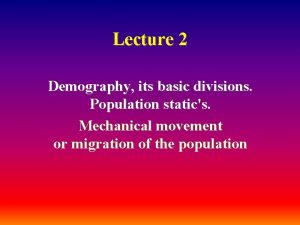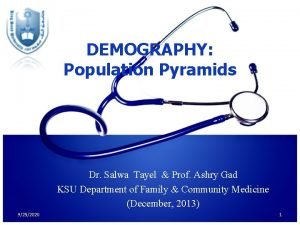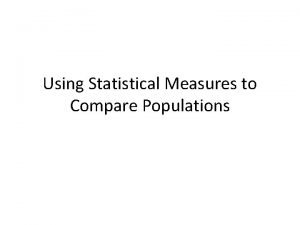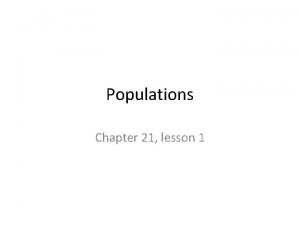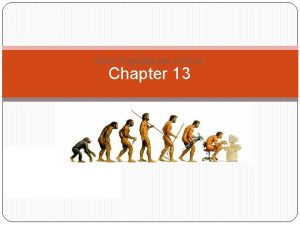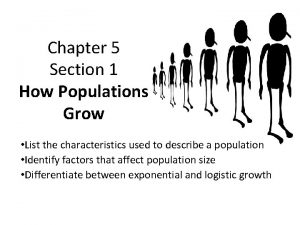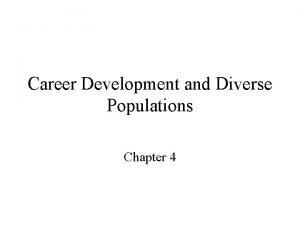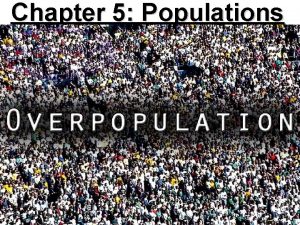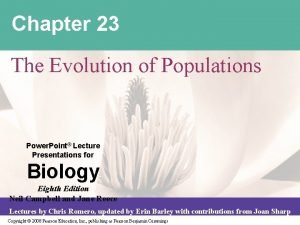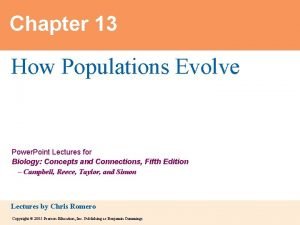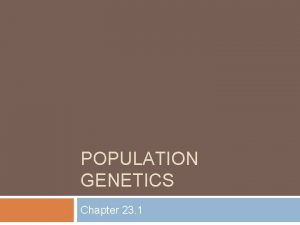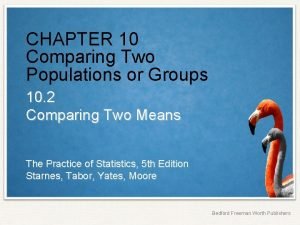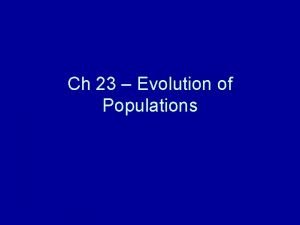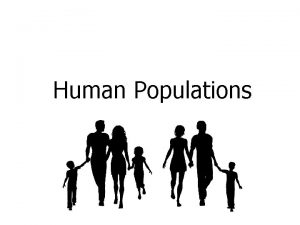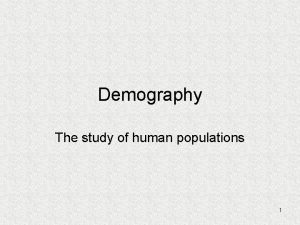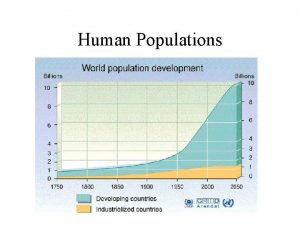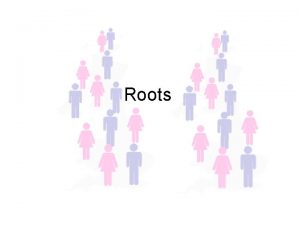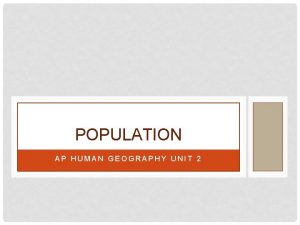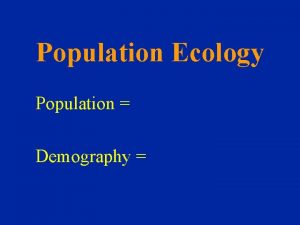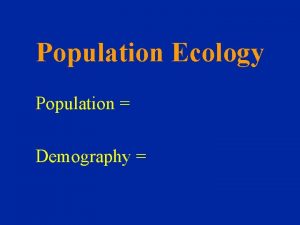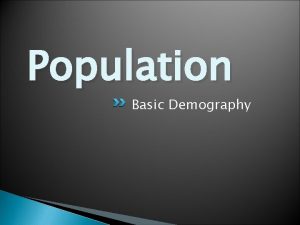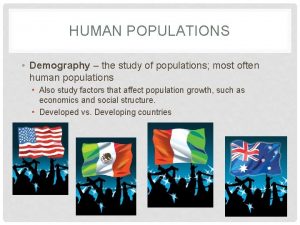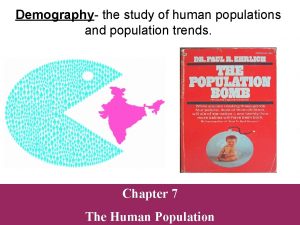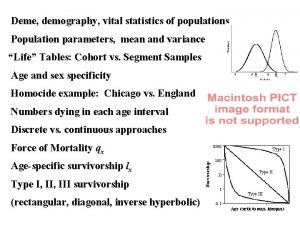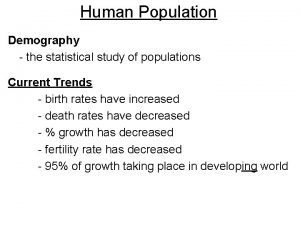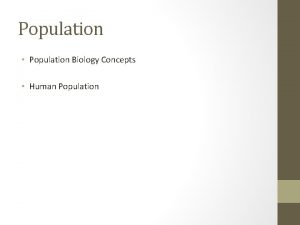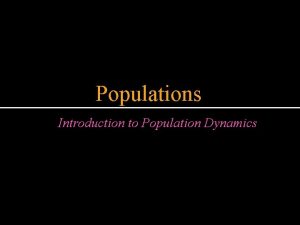Populations an Introduction to Demography Population Trends In

























































- Slides: 57

Populations: an Introduction to Demography Population Trends In Canada

Demography • Demography is the study of populations over time and over place.

Three major Components of demography are: 1. Mortality, 2. Fertility, 3. and Migration.

I. Mortality 1. Mortality deals with death rates in a population;

II. Fertility 2. In 2002, Canadian women gave birth to 328, 802 babies, down 1. 5 per cent from the year before. • It was also the eleventh decline in 12 years.

Birthrate less than 2= negative population growth • IMMIGRATION IS VITAL… • Definition: This entry gives the average annual number of births during a year per 1, 000 persons in the

Stats. Can • Birth rate: 10. 29 births/1, 000 population (2008 ). Fertility rate will be only 1. 3 children per woman by 2010. • Population (2009 est. ): 33, 487, 208 (growth rate: 0. 8%);

BABY BOOM – Population Bulge • The substantial increase in the birth rate (from 1947 to approximately 1966), following the Second World War

BABY BOOM • The baby boom was most apparent in Canada, US, Australia and New Zealand. • In 1996, the baby boom generation were 33% of the Canadian population

III. Migration • Net migration-

Canada Birth Rate: 10. 75 births/1, 000 population (2007) • Births and Migration-stabilize populations, thus immigration vital to economic stability in Canada.

Demography Studies… • Demographers are interested in the determinants of these three population components as well as in their effects on various elements of

Demographic Impact • These effects above affect not only population dynamics. They also impact: 1. Economic patterns 2. Social processes 3. Social policy

Boom, Bust and Echo • • A Key demographic text… 1989) By David K. Foot.

The Demographic Transition • The demographic transition refers to changing levels of mortality and fertility in countries over time.


Definition • The process of explaining the transformation of countries • from high birth rates and high death rates to…

Definition • …low birth rates and low death rates as part of the economic development of a country. • TRANSITION= from a pre-industrial to an industrialized economy


Pre-industrial(pre-1750), Demographics • Prior to the industrial revolution… • Problems: • The availability of food, infectious diseases, poor hygiene and sanitation, & no. . modern medicine.

Population and Social Structure • In 1871, 55% of the labour force worked on farms. • By 1971, only 6% worked in an agricultural occupation.

THE STATE and Dependency 1. In Canada. Average -life expectancy in 1900 was 47 years. 2. Today it is 77 and rising. .

i. e. Canadian Dependency Ratio • MORE Elderly PEOPLE TODAY= More dependency… • STATE MUST SUPPORT…. Elderly and Young…

Industrial revolution • During the industrial revolution (post 1750), • Eng, Fr and Ger. led to a drop in mortality rates, followed by a decline in fertility rates. .

Industrialization • This stage of the demographic transition therefore resulted in excess fertility and significant population growth

Epidemiological transition • Begins once there are improvements in food distribution, nutrition, water quality, personal hygiene, public sanitation, education, and economic development

Epidemiological transition • Increase in life expectancy, • Due to improvements illness and disability management and self-care.

i. e. Healthy Heart Programs • For example, we have witnessed the development of Healthy Heart Programs, the Arthritis Self Management Program, and diabetes programs in recent years

Population Aging • The proportion of the Canadian population over the age of 65: 1. 13. 7 per cent in 2006; 2. 13 per cent in 2001; 3. 12. 2 per cent in 1996.

Baby boomers • The highest rate of population aging will occur between 2011 and 2031. • Population in Canada increasingly looks like an inverted vase.

Median age • The median age in Canada was 37. 6 years in 2001, 39 in 2007, and it is projected to increase to 41 years by 2011. • This means that by 2011, one-half of Canadians will be aged 41 or over.

The youngest region • The youngest region in Canada is Nunavut, with a median age of 23. 5 years because of high fertility levels. • Reason: Survival, poverty. etc. .

Boom, Bust and Echo (1996) • Foot’s main thesis is that economic trends in Canada are largely dictated by the stage of life and financial status of the baby boomers. .

Current Ages of Boomer 1. The oldest of Canada's almost 10 million baby boomers -- people born between 1946 and 1964 -- are entering their early 60 s.

For example, • Foot predicts that the housing market will shrink and prices will drop because most baby boomers have purchased their homes and younger cohorts are smaller in size

Limitations of Demography • ‘Demographic determinism’ or ‘apocalyptic demography’ • Ignores intervening variableseconomic, political, social…researchers and media have used or misused demographic data to present a crisis when the factual evidence does not support it.

Dependency ratio, • Dependency ratios are calculated by dividing the proportion of the population not in the labour force by the proportion in the labour force. • Using the population aged 0 to 19 and those aged 65 and over divided by the remaining population (20 to 64).

Calculating Dependency • When a large proportion of the population is not in the work force, there are proportionately more people receiving benefits and a smaller proportion contributing taxes than when the dependency ratio is lower.

Old age dependency • As the population has aged over the last several decades, the old age dependency ratio has increased. • Some note crisis: Aging pop and welfare, aging pop and health care… • Politicization of the Aged.

Peak Dependency • Contrary to what most people believe, the overall dependency ratio actually peaked in the late 1960 s and early 1970 s. • Future projections indicate a further reduction in the total dependency rate as a result of prolonged low fertility

Pension Systems • The current fiscal problems related to the Canadian pension system are complex, a few major points can be made to add to the ones discussed in the text.

CPP and QPP • First, since they were developed in the 1960 s, the provincial governments have borrowed against the CPP and QPP (Canadian and Quebec Pension Plans) for capital development, such as roads, hospitals, and so on. These provincial debts have not been erased

Reductions in pensions • The federal government has been pressured into looking for ways to decrease the debt, including reductions in pensions to older adults, such as through delaying the age of eligibility from 65 to 67.

RRSP • Other reports show that between 1991 and 2004, the number of paid workers in Canada covered by a Registered Pension Plan declined to 39 per cent from 45. 3 per cent at the same time as the proportion of workers covered by defined benefit pension plans is declining

The Future • Retired Canadians will need some combination of Old Age Security (OAS), Canada and Quebec Pension Plans (CPP), home ownership, a workplace pension plan, and savings through an RRSP as well as non-registered savings.

Federal government • The federal government has also reduced tax transfer payments to the provinces over the last two decades, resulting in cuts to health care and education budgets. The high costs of health care, especially for people aged 80 and over, represent one major aging -related controversy within the social policy arena

Mortality and Life Expectancy • Today, life expectancy at birth for Canadians is estimated to be approximately 80 years. • In 2006, it was 82. 5 years for women, and 77. 7 for men.

Women vs. Men • Life expectancy have slowed for women in recent years. • Perhaps women have reached a temporary threshold in life expectancy improvement or, alternatively, the life expectancy for women may be beginning to converge with that for men.

Summary • Demography is the study population aggregates (Quanititative) to predict social patterns • Demography compliments sociology • Its focus is qualitative but combined with qualitative sociological understanding, demography assists in understanding trends in modern societies such as Canada.

United Nations • According to the United Nations Human Development Index, Canada has the highest quality of life in the world. • Contrary to popular opinion, Canada does not own the North Pole. In fact, the North Pole is not owned by any country. It is believed, however, that Santa Claus is from Canada!!! • Canada is the world's eighth biggest trader.

CANADA • Canada is the second largest country in the world, with 9, 971, 000 square kilometres of land. • With only three people per square kilometer, Canada has the fourth lowest population density in the world. • Vancouver Canada is tied with Zurich Switzerland for the highest quality of life of any city in the world. • Canada has the ninth biggest economy of the world

Geographic Distribution • • In 2006, a majority (about 81 per cent) of Canada’s older population resided in urban centres with populations of 100, 000 or more.

Aging Provincial and Municipal • 14. 6 per cent of the BC population was 65 and over, compared to only 2. 7 per cent in Nunavut. • At the municipal level, Parksville, BC has about one-third of its population in the senior range,

• compared to Barrie, ON at the opposite extreme, which has one-fifth aged 14 and under.

Ethnic composition and Aging • Ethnic composition of a population affects aging processes in a number of significant ways because of the importance of ethnic culture on attitudes, values, and behaviours

Minority Culture and Aging • Persons of oriental culture are more likely to live in extended families than those of predominantly white culture. • Immigration trends have shaped our ethnic composition. In 2006, about 25 per cent of elderly people were born outside of Canada.

Ethnic Origin Changing • This is higher than the percentage for the whole population because many immigrants came to Canada as young adults after WWII. . • The country of origin has been changing over time, which is resulting in a highly diverse ethnic composition in Canada.
 Demographic data definition
Demographic data definition Static demography
Static demography Cso business demography
Cso business demography Elements of demography
Elements of demography Demographic transition model ap human geography definition
Demographic transition model ap human geography definition Difference between a sample and a population
Difference between a sample and a population Components of demography
Components of demography Demography antonym
Demography antonym Chapter 4 section 1 population dynamics
Chapter 4 section 1 population dynamics Section 1 population dynamics answer key
Section 1 population dynamics answer key Population ecology section 1 population dynamics
Population ecology section 1 population dynamics Chapter 4 section 1 population dynamics answer key
Chapter 4 section 1 population dynamics answer key Using statistical measures to compare populations
Using statistical measures to compare populations Territoires populations et développement quels défis
Territoires populations et développement quels défis Stabilizing selection human birth weight
Stabilizing selection human birth weight A biologist discovers two populations of wolf spiders
A biologist discovers two populations of wolf spiders Punnett square limitations
Punnett square limitations Lesson 1 populations answer key
Lesson 1 populations answer key Section 19-1 review understanding populations
Section 19-1 review understanding populations Chapter 16 evolution of populations vocabulary review
Chapter 16 evolution of populations vocabulary review Individuals don't evolve populations do
Individuals don't evolve populations do Populations biology definition
Populations biology definition Whats a density dependent factor
Whats a density dependent factor Kar 5
Kar 5 Chapter 13 how populations evolve test
Chapter 13 how populations evolve test Chapter 17 evolution of populations answer key
Chapter 17 evolution of populations answer key 5-1 how populations grow
5-1 how populations grow Chapter 5 lesson 1 how populations grow
Chapter 5 lesson 1 how populations grow Chapter 23: the evolution of populations
Chapter 23: the evolution of populations Evolution of populations section 16-1 genes and variation
Evolution of populations section 16-1 genes and variation Chapter 16 evolution of populations
Chapter 16 evolution of populations Evolution of populations section 11 review
Evolution of populations section 11 review Chapter 10 comparing two populations or groups answer key
Chapter 10 comparing two populations or groups answer key Gage definition
Gage definition Ringe til peru
Ringe til peru 5-1 how populations grow
5-1 how populations grow Chapter 8 understanding populations
Chapter 8 understanding populations Complex patient populations
Complex patient populations Section 5-1 how populations grow
Section 5-1 how populations grow Chapter 23 the evolution of populations
Chapter 23 the evolution of populations Dynamique des populations
Dynamique des populations Chapter 21 vulnerability and vulnerable populations
Chapter 21 vulnerability and vulnerable populations Chapter 13 how populations evolve
Chapter 13 how populations evolve 99image
99image Genetic drift in small populations
Genetic drift in small populations Speciation
Speciation Founder effect genetic drift
Founder effect genetic drift Chapter 10 comparing two populations or groups
Chapter 10 comparing two populations or groups Smallest unit of evolution
Smallest unit of evolution 5-1 how populations grow
5-1 how populations grow Essay structure
Essay structure Equifax national consumer credit trends report
Equifax national consumer credit trends report Ontogenetic market forecast
Ontogenetic market forecast Trends for atomic radius
Trends for atomic radius Search image
Search image Thomas gray as a romantic poet
Thomas gray as a romantic poet Packaging industry in india
Packaging industry in india Memory hierarchy
Memory hierarchy

